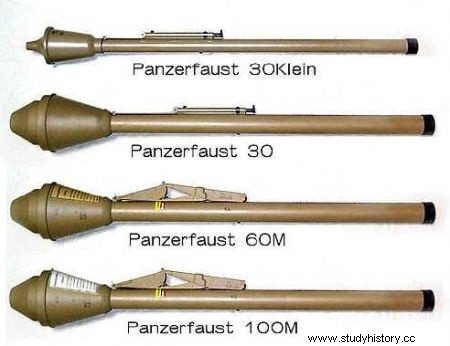
Panzerfaust 30 (Klein)
Scope: 30 m.
Projectile diameter :100 mm.
Weight:total , 1.475 kg;
projectile, 0.680 kg.
Initial speed speed:30 m/s.
Perforation :140 mm shielding.
Panzerfaust 30
Scope :30 m.
Diameter of the projectile :100 mm.
Weight:total, 5.220 kg;
projectile , 3 kg.
Initial speed speed:30 m/s.
Perforation :200 mm shielding.
Panzerfaust 60
Scope: 60 m.
Projectile diameter :100 mm.
Weight:total, 6,800 kg;
projectile , 3 kg.
Initial speed speed:45 m/s.
Perforation: 200 mm shielding.
When it first appeared in 1942, the machine that was immediately known as Panzerfaust (the devil of the tank) was unique in its kind. This weapon developed by the company HASAG (Hugo Schneider AG) of Leipzig, in order to equip the soldiers with an individual anti-tank means, resembled a kind of recoilless cannon taking up certain principles of the rocket. As it had to be simple and cheap, it was reduced to a tube capable of launching a shaped charge grenade. It had a sighting system and basic pointing devices, and that was it. The launch tube contained the majority of the propellant charge and four steel fins deployed in flight to ensure the stability of the projectile.
The commissioning of the first Panzerfausts became widespread from 1943 in the initial version later called Panzerfaust 30 (klein), the number 30 corresponding to the range in meters of the machine. The word klein (small) was added because a larger caliber projectile, the Panzerfaust 30, quickly succeeded it to increase its piercing power. The short range of the first models was a serious handicap for the shooter, who had to approach very close to his target. The Panzerfaust worked well though, and destroyed any armored craft it could hit. Its pointing represented a delicate operation, because it depended on the use of a folding hinged rise which had to be aligned on a mark placed on the body of the projectile, while maintaining the tube under the arm to avoid being burned. by propellant gases, a most unpleasant possibility for the shooter.
The Panzerfaust 60 and Panzerfaust 100 replaced the model 30. Their greater propellant charge gave them a greater range. The Germans planned to make a Panzerfaust 150 and a Panzerfaust 250, but the end of the war interrupted the realization of these projects at the test stage.
The projectile of the last Panzerfaust pierced 200 mm of armor under an incidence of 30°, and that of the Panzerfaust 30 (klein), 140 mm. All Allied tanks were therefore vulnerable and their crews had to take protective measures for their vehicles, for example by installing additional steel plates on their sides, by piling sandbags around the hull, or by fixing track elements at the most sensitive locations. The Germans built Panzerfaust by the tens of thousands until May 1945. These weapons being used only once, their manufacture resulted in a very strong levy on raw material resources. This is why the planned Panzerfaust 150 and 250 had to be reloadable.
The Panzerfaust was perfectly suited to German defensive tactics in 1943-1945, and Allied tank crews feared it. It was the weapon par excellence of the Volkssturm fighters who fought the final battles.
Characteristics
